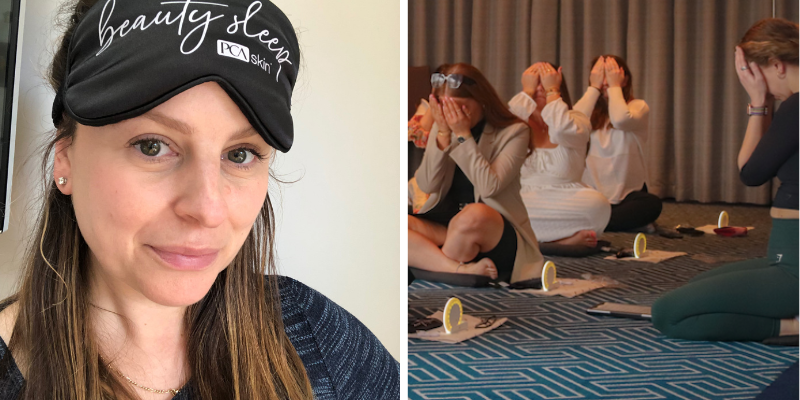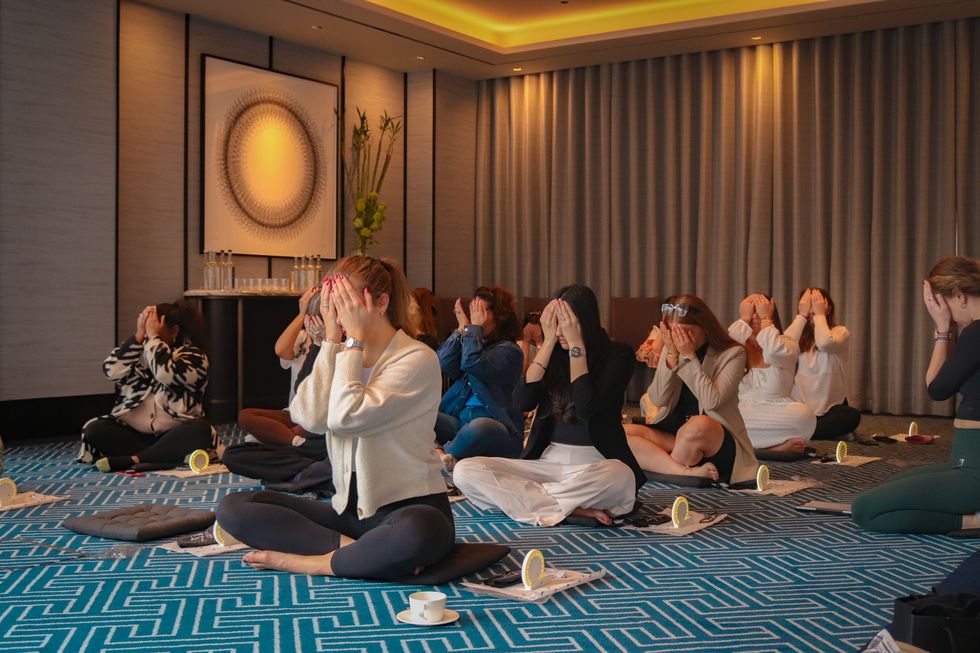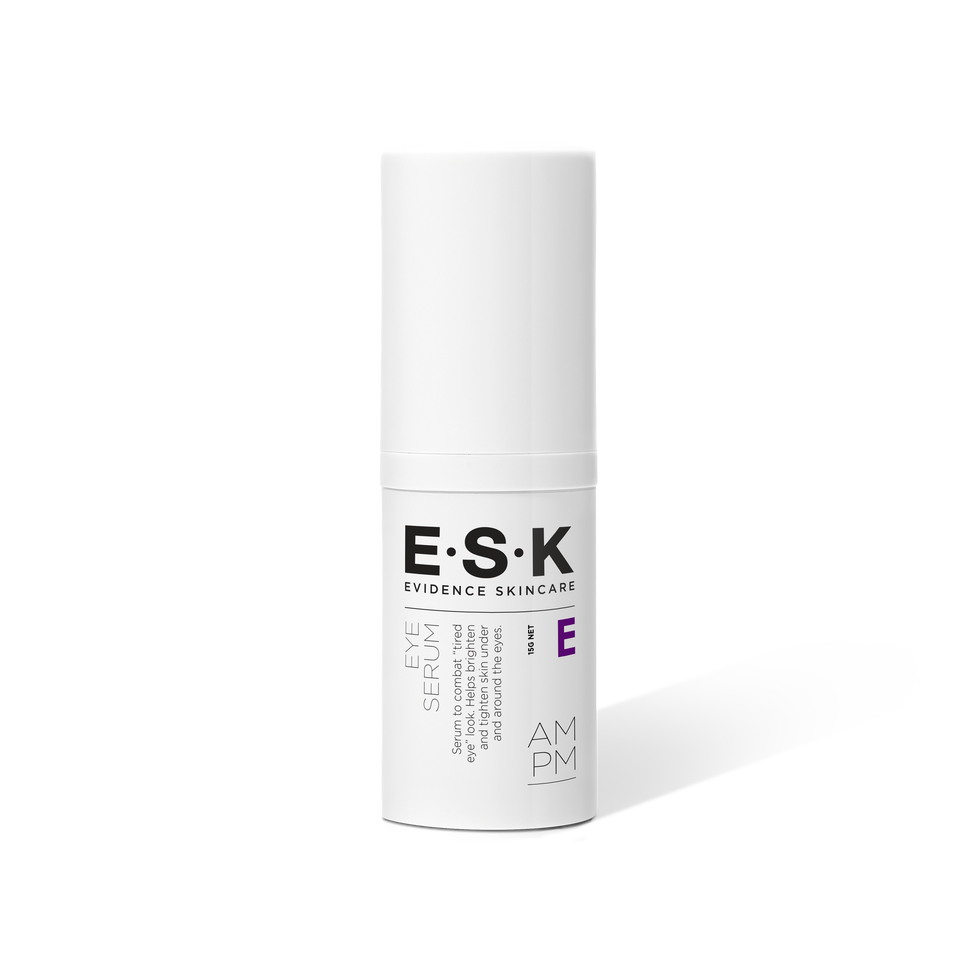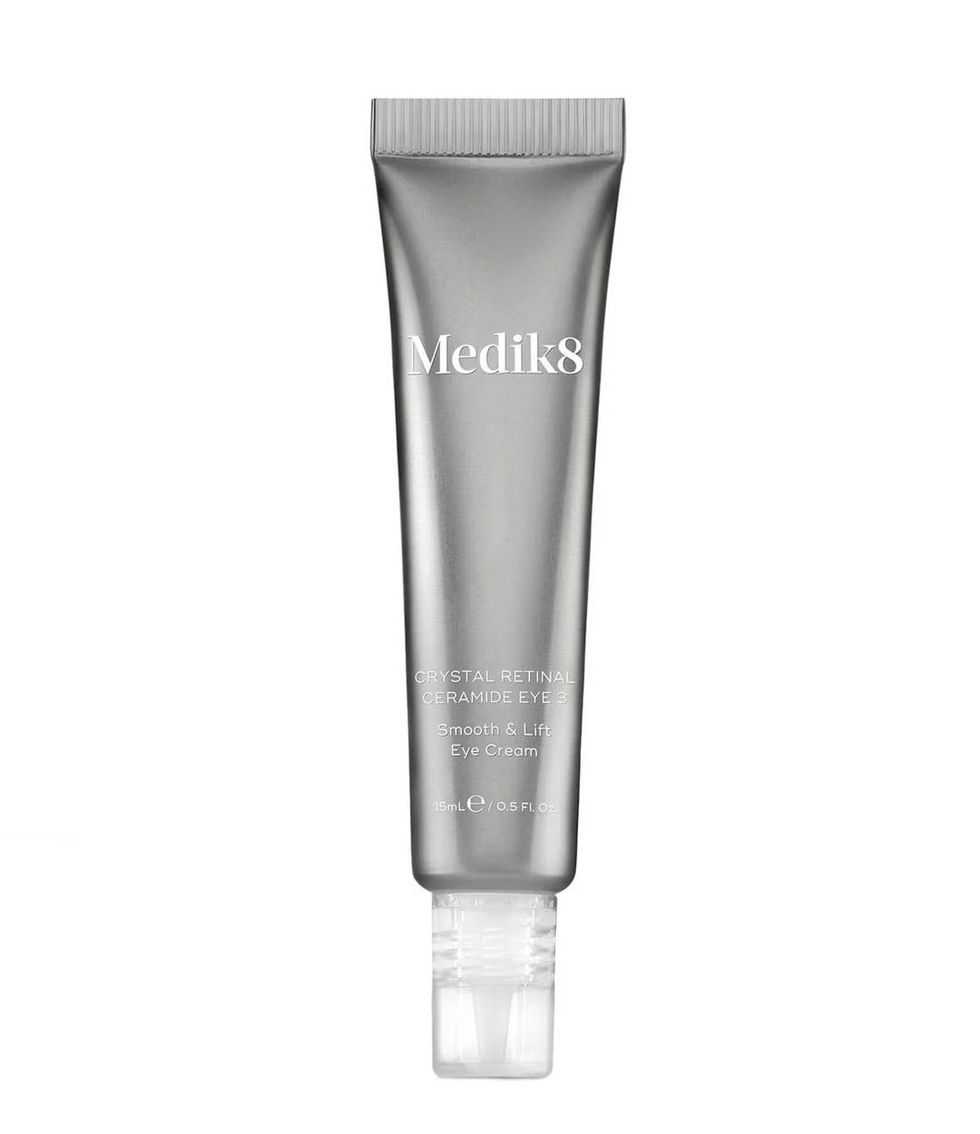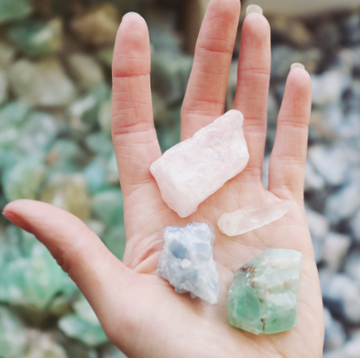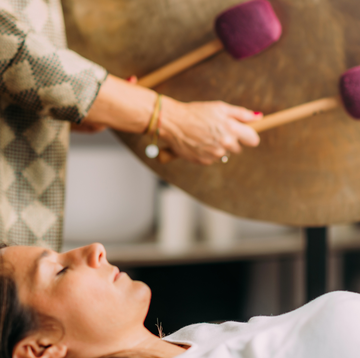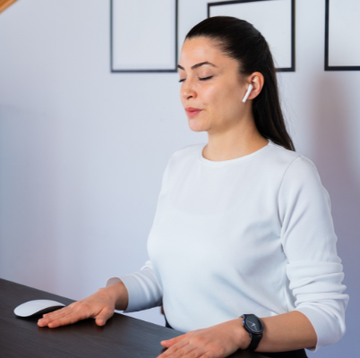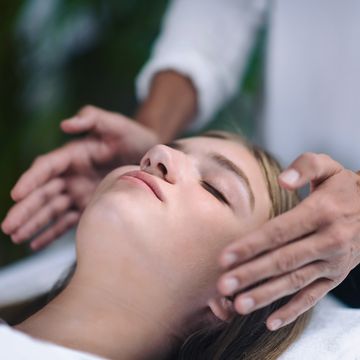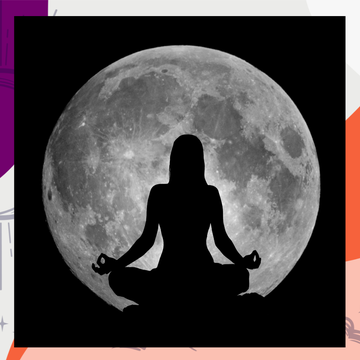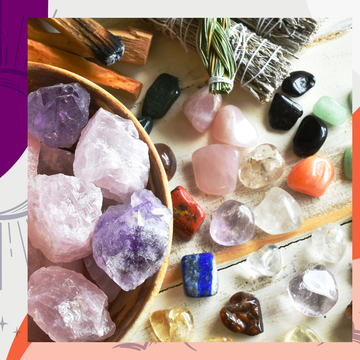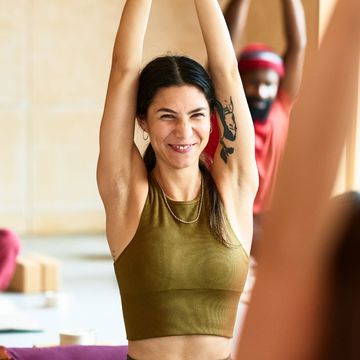When it comes to yoga, I’m very much a hobbyist – I’ll happy go along to a class when it’s on offer, but I’m not disciplined enough to follow a regular practise at home. Basically, I sit somewhere between WH’s Fitness Editor and bonafide yogi, Bridie, and WH Editor-in-Chief, Claire, who just has zero interest in the who concept.
However, when the invite came in to give eye yoga a go, I was intrigued. And it turns out I wasn’t the only one. In fact, when I told people I was going to an eye yoga session, they were instantly curious, questioning me about what it actually is. So, in the interest of having to tell everyone on repeat, here’s what I learned about eye yoga from my session.
What is eye yoga?
Basically yoga, but for your peepers – think moves which will help relax, support and strengthen those all-important ocular muscles.
This involves a series of eye exercises designed to support eye health and improve your vision. Palming, zooming, blinking, eye-rolling and staring off into the distance are all techniques you can expect to try as part of an eye yoga session.
Want to give these moves a try? Keep scrolling...
What happens in an eye yoga session?
‘The physical practice of eye yoga involves exercising and relaxing the eyes,’ says Jess Parkinson, breath-work instructor, yoga teacher, and Gymshark Fitness Pro. ‘These exercises work by moving the eyes in ways that they don't get exposed to as often in our modern, technology-driven lives, as well as helping them to relax.’
Consequently, Jess’s practise involves lots of movements which focus on ‘divergence’, the action of distance gazing. If it sounds like just daydreaming and writing it off as wellness, you’re not wrong. ‘Spending time in our day looking out of the window or looking out at the view from the train on our daily commute actually has a direct impact on our stress levels and positively impact our well-being,’ explains Jess.
This is because ‘the more we spend time on our devices or looking at things very close to us, the more we take the eyes into a position called "convergence". In terms of our stress levels, convergence is interestingly linked to the sympathetic nervous system or the "fight and flight" as most people know it. The longer we spend in this position the more likely we will begin to breathe less efficiently, develop tension and feel physical tension in the body and develop symptoms of stress or anxiety.’
Finally, an eye yoga session also comes with a fair dose of relaxation throw in. ‘I also include certain meditation techniques such as focusing on the third eye chakra (ajna) and repeating affirmations or gratitude statements related to our sight - this sort of meditation can increase feelings of contentment as well as improve positivity,’ says Jess.
‘I also include breath-work practices that enhance the benefits of the eye exercises such as extending the exhales as we breathe. Again, this helps to down-regulate the nervous system, relax the body and increase overall feelings of well-being.’
What are the benefits of eye yoga?
If it all sounds a bit like glorified daydreaming, bear with us – there are expert-approved benefits to the practise. According to Consultant Ophthalmic and Oculoplastic Surgeon, Dr Elizabeth Hawkes, eye yoga can help minimise strain by manipulating the muscles in the eyes to strengthen them.
‘After the brain, the eye is the most complex organ in the body and there are many confounding factors affecting sight and ageing of the eye,’ she explains. ‘There are muscles in the eyelid, on the eyeball and inside the eye. All are very important and are controlled by the nervous system and brain.
'The muscles on the outside of the eyeball are called extraocular muscles – we have six – and there are also muscles inside the eye which cause contraction of the natural lens and allow us to focus on objects close up.’
By strengthening these muscles, Dr Hawkes believes you can support ocular health. ‘Whilst there is no robust evidence to support eye yoga to delay sight conditions and improve eye health, in theory strengthening our eye muscles of accommodation by focusing on an object in the distance and then an object up close is a very good idea,’ she says.
‘Strength is important for every muscle in the body and taking a holistic approach to health is a good complement to conventional medicine.’
Does it really work?
In all honesty? The jury is still out on this one thanks to a lack of clinical evidence.
If you’re looking for a silver bullet for ocular health, this isn’t the one – you’ll need specialist treatment to cure any eye problems you have, advises Dr Hawkes. However, she does say that it does most likely provide some benefits when it comes to keep the eye muscles strong and potentially minimising strain.
‘Whilst there is no robust evidence to support eye yoga to delay sight conditions and improve eye health, in theory strengthening our eye muscles of accommodation by focusing on an object in the distance and then an object up close is a very good idea,’ says Dr Hawkes. ‘Strength training is important for every muscle in the body and taking a holistic approach to health is a good complement to conventional medicine.’
The message? Trying eye yoga certainly can’t hurt, especially when we’re spending so much time staring at screens every day. But Dr Hawkes makes the valid point that there’s no point spending your time putting your peepers into the ocular equivalent of a downwards dog if you aren’t backing this up with a targeted skincare routine too.
What skincare will help support eye yoga?
PCA Skin Vitamin B3 Eye Brightening Cream
Designed to diminish dark circles and give a brightening boost, PCA’s brand new brightening cream is formulated with 5% niacinamide – a form of Vitamin B3. This vit is proven to reduce edema (a.k.a swelling) around the eyes, as well as helping to protect delicate under-eye skin from visible effects of stress, and UV and blue-light induced damage.
ESK Eye Serum
PSA announcement: ESK stands for Evidence Skin Care, meaning that all this brand’s products are based on scientific evidence, rather than beauty-industry hype. This eye serum is a rich blend of organic, peptide and antioxidant ingredients, designed to lighten, tighten and brighten the skin under and around the eyes. What more could you want?
MEDIK8 Crystal Retinol
Retinol is your MVP when it comes to combatting fine lines and signs of ageing. This effective serum is great for beginners as it lets you build up the strength of this ingredient by swapping for a stronger version as your skin acclimatises, helping you avoid irritation. Remember, retinol is a vitamin A derivative, so it’s not safe to use if you’re pregnant or breastfeeding.
My experience of eye yoga
I’m going to level with you, it felt a lot like an eye test at times. After all, aside from that last convo with your ex, when did you do so much purposeful eye-rolling?
It was also not as easy as I’d anticipated (I’m known for my love of a lazy fitness challenge). Working your eye muscles to test your peripheral vision is trickier than it sounds, and the process made me realise that I probably should be giving my eye muscles a daily flex since I spend so much time looking at a screen.
But this doesn’t mean it wasn’t also quite relaxing. There’s something very peaceful about being given permission to stare out of a window, and my eyes felt properly tired when we rested them at the end of the session with a savasana. Would I go to a dedicated eye yoga session again? Probably not, but I’d definitely take away the learnings and try to integrate some of the exercises into my day-to-day to help keep my peepers working well.
FIVE EYE YOGA EXERCISES TO TRY
Jess Parkinson talks us through her top moves for training those ocular muscles
Palming
Rub the palms of your hands together for 15 seconds to warm them and then gently place them over your eyes. Take deep breaths and relax for a few minutes, repeating as necessary. This almost sets the scene for eye yoga. Relaxation plays a very important part of mental wellbeing, and whilst this won't have a big impact on eye strength, it will help you destress.
Blinking
This exercise is particularly beneficial for those suffering from Dry Eye Disease. The tears created when blinking will lubricate the eyes, sweeping your tears across the cornea which then helps to nourish the eye and provide clarity of vision. To do this exercise, open your eyes and then rapidly blink ten times. Rest with your eyes closed for around 20 seconds and then repeat another 5 times.
Zooming
This is particularly important for those who work on screens for the majority of their day. Look at an object in the distance and try to focus on it as clearly as you can. Then, very slowly, shift your gaze to an object that is very close up, which will cause your pupils to constrict. Try to take deep breaths as you are doing this to stay relaxed and focussed.
Figure of 8
This is great to stimulate the extraocular muscles, which are responsible for moving the eyes. Focus on an object or point on the floor about 3 metres away and trace a figure of 8 with your eyes.
Eye-rolling
Keep your head still, focus your gaze at the ceiling, then slowly rotate in a clockwise direction, gently focusing on objects in your periphery. Repeat in an anticlockwise direction, and repeat around three times for each direction to help strengthen your eye muscles.
